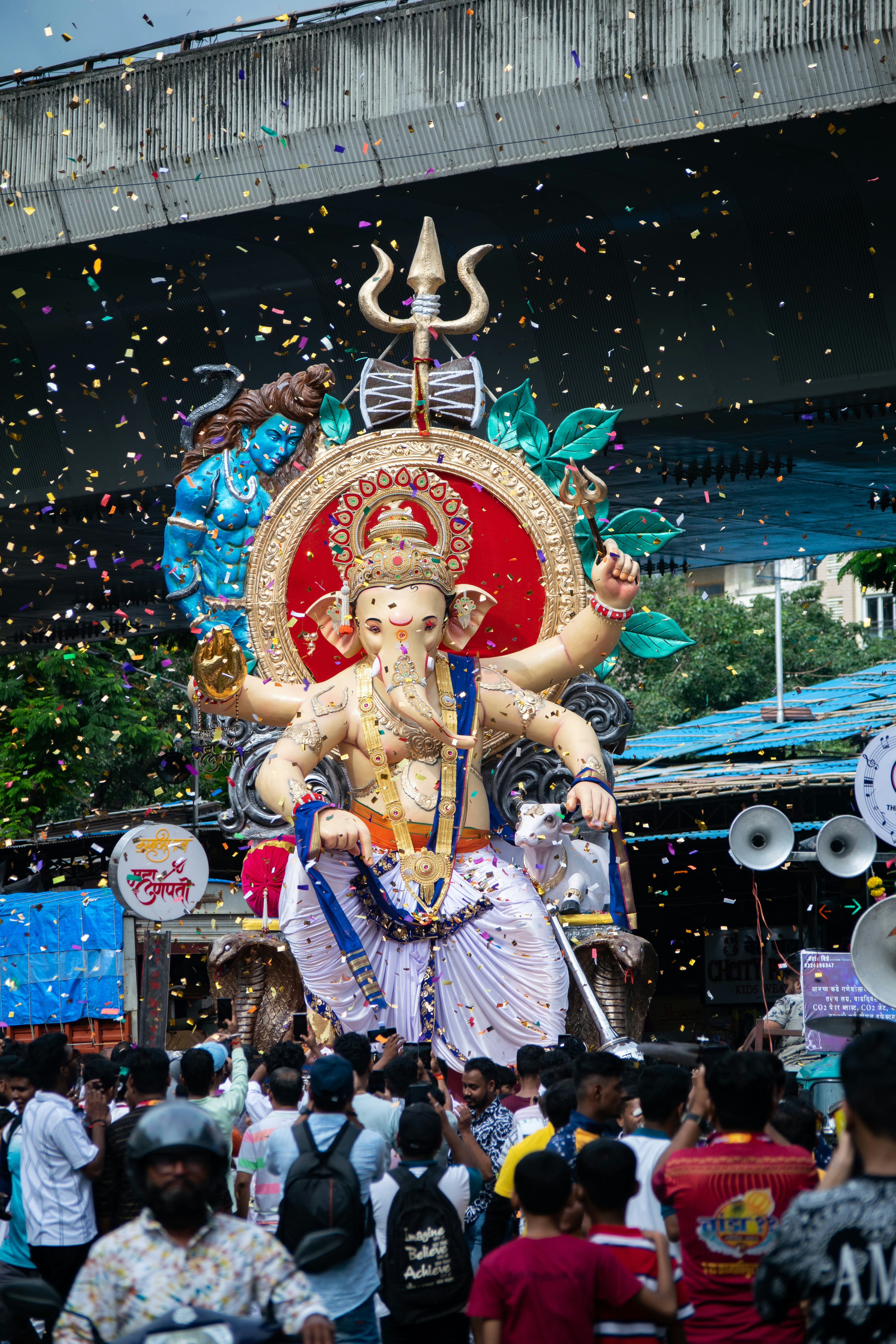
Ganesh Chaturthi is a vibrant festival celebrated with great enthusiasm across India and among Hindu communities worldwide. This annual observance marks the birth of Lord Ganesha, the revered elephant-headed deity, who symbolizes wisdom, prosperity, and new beginnings. The roots of Ganesh Chaturthi can be traced back to Hindu mythology, particularly to the Puranas, which elaborate on the divine origins of Ganesha. According to legend, he was created by Goddess Parvati, who molded him from clay in her dwelling. This act signifies the intrinsic bond between the divine feminine and the creative forces of the universe.
The significance of Ganesh Chaturthi extends beyond mere celebration; it embodies the values of devotion, community solidarity, and the auspicious start of new endeavors. Devotees celebrate the festival with elaborate rituals and offerings, reflecting their reverence for Ganesha as a remover of obstacles. This aspect makes Ganesh Chaturthi particularly important for those embarking on new journeys, whether they be personal, professional, or spiritual. By invoking Lord Ganesha at the outset of these ventures, devotees seek his blessings to ensure success and harmony.
Moreover, the festival acts as a catalyst for cultural enrichment and community bonding. During this time, public decorations and artistic displays of Ganesha idols become focal points for congregational worship. The colorful processions and vibrant celebrations manifest a shared spirit, uniting people across diverse backgrounds in devotion. As such, Ganesh Chaturthi is not only a period for personal reflection and spiritual growth but also an opportunity to foster connections within the community. In essence, the festival resonates with the universal ideals of hope, renewal, and the pursuit of wisdom, making it a significant event in the spiritual calendar.
Rituals and Traditions of the Festival
Ganesh Chaturthi is a time of exuberance and devotion, marked by a rich tapestry of rituals and traditions that bring communities together in celebration. The festival begins with the installation of Ganesha idols, which is a significant event for devotees. Typically, the idols are made from clay and come in various sizes, representing the beloved elephant-headed deity. Families often bring the idol into their homes or set it up at community pandals, transforming these spaces into vibrant shrines adorned with flowers, lights, and decorations that embody the spirit of the festival.
The worship practices associated with Ganesh Chaturthi are meticulous and steeped in tradition. Early in the morning, devotees offer prayers known as ‘puja’. This involves invoking Lord Ganesha through the chanting of mantras, and the offering of items such as modaks (sweet dumplings), fruits, and flowers, which are believed to please the deity. The recitation of the Ganapati Atharvasirsha, a sacred scripture, often accompanies these rituals, enhancing the spiritual atmosphere. Each day of the festival is marked with different prayers, bhajans, and various rites to honor Ganesha, effectively deepening the individual’s connection to the divine.
The festival culminates on the final day with a grand procession, an event that showcases the joy and unity within the community. Devotees, adorned in festive attire, gather to carry the idol through the streets, accompanied by lively music, singing, and dancing. This vibrant procession symbolizes the farewell to Lord Ganesha, who is believed to return to Mount Kailash to his divine abode. The immersion of the idol in water bodies serves as a poignant reminder of the transient nature of life and invites devotees to reflect on the blessings received during the festival. Ganesh Chaturthi is thus a profound experience, blending devotion, culture, and communal harmony.
Eco-Friendly Celebrations in 2025
As environmental awareness continues to grow, the celebration of Ganesh Chaturthi in 2025 is witnessing a significant shift towards eco-friendly practices. More devotees are embracing the use of clay and seed Ganesha idols, which are not only biodegradable but also promote sustainability. These idols, crafted from natural materials, dissolve in water without leaving harmful residues, unlike conventional idols made from plaster of Paris that contribute to pollution and water toxicity. Seed Ganesha idols take this concept a step further, as they can eventually be planted, allowing devotees to nurture the rebirth of their beloved deity into a living plant.
In addition to the choice of idols, the decoration techniques during this festive season have also transformed remarkably. Celebrants are now opting for minimal and natural decorations, such as using flowers, leaves, and other organic materials. This not only enhances the aesthetic appeal of the festivities but also reduces plastic waste, which is a significant contributor to environmental degradation. Simple decor elements like handmade paper lanterns and reusable cloth banners are gaining popularity, reflecting a conscious effort to integrate tradition with ecological responsibility.
The shift towards eco-friendly celebrations has a profound impact on reducing environmental pollution, which is critical in today’s context of climate change and biodiversity loss. Communities are coming together to share ideas and resources, fostering a spirit of collaboration while emphasizing the need to preserve cultural heritage. It is possible to honor our traditions with reverence without compromising the health of our planet. Thus, the trend of eco-friendly Ganesh Chaturthi celebrations in 2025 symbolizes a harmonious blend of devotion, joy, and environmental stewardship, encouraging future generations to engage in responsible festive practices.
Ganesh Chaturthi Celebrations Across India
Ganesh Chaturthi, an auspicious festival dedicated to Lord Ganesh, is celebrated with immense devotion and grandeur across India. Each state exhibits its unique customs and practices, showcasing the rich tapestry of Indian culture through various festivities and traditions. One of the most prominent celebrations occurs in Maharashtra, where large public pandals are erected, and elaborate idols of Lord Ganesha are installed. The atmosphere is filled with vibrant processions, traditional music, and folk dances, culminating in the immersion of idols in water bodies on the last day of the festival. This celebration not only fosters a sense of community but also reflects Maharashtra’s cultural heritage.
In Karnataka, the celebrations include a distinctive blend of rituals and local traditions. Families perform pooja with a fervent devotion, often inviting local musicians to engage in traditional folk performances. The culinary aspect of the festival is equally vital, featuring delectable offerings such as modaks, which are believed to be Lord Ganesha’s favorite delicacy. The festivities here are characterized by a communal spirit that binds people together through shared rituals and joyous gatherings.
Moving southward to Tamil Nadu, the festival is marked by an elaborate display of artistic expressions. The devotees create intricate kolams (designs made with rice flour) at entrances to welcome Lord Ganesh, and the celebrations include classical music and dance performances that pay homage to the divine. Telangana also shares this fervor, with rituals that resonate deeply with local culture, including energetic folk dances that invigorate the celebrations.
In Goa and Andhra Pradesh, the festival unveils a colorful array of traditions, from traditional songs to vibrant local celebrations. Goans celebrate the event with cultural programs and a sense of communal unity, while in Andhra Pradesh, the focus often lies on devotional singing and colorful processions. These diverse celebrations reflect the rich cultural heritage of India, highlighting how Ganesh Chaturthi serves as a significant event that unites people across different regions in joyful homage to Lord Ganesh.
